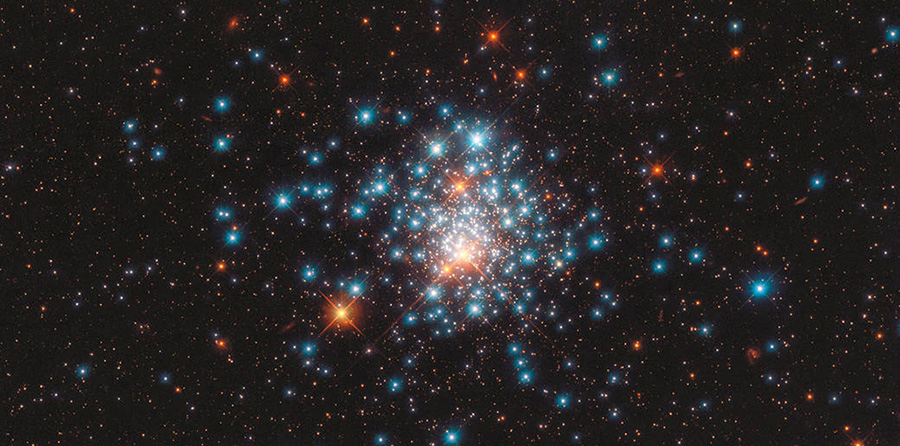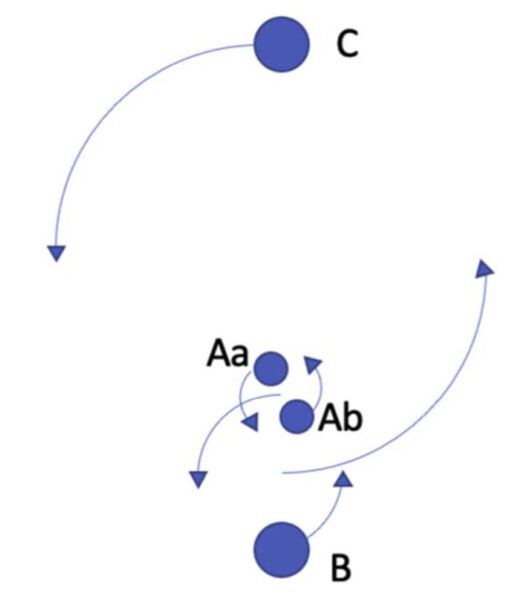Stars are most often born as multiples. Now, the TESS telescope has caught one of these multiple systems in a unique setup.

ESA / Hubble & NASA / J. Kalirai / CC BY 4.0
There are light curves, then there are light curves. Recently, astronomers untangled a particularly complex signal and revealed its surprisingly elegant cause: not one, two, or even three, but four stars locked into a never-ending dance.
A Mystery Light Curve
Over the past 20 years, astronomers have piled up quite the hoard of stellar light curves. Most of these are predictable, fairly simple time series: sure, the brightness of a given star might oscillate pseudo-regularly around its average as star spots come and go or the star shrinks and swells, but by and large, most curves don’t reveal anything surprising. A handful of exciting curves shelter the telltale signature of a transiting planet. Another handful hosts the unfortunately similar signature of eclipsing binary stars. Almost all of them can be explained by fairly simple models, just one or two stars and their planets going about their usual lives.
However, a few light curves among the hundreds of thousands recorded so far are bafflingly weird. Take the measurements of the source named TIC 114936199, which the Transiting Exoplanet Survey Satellite (TESS) watched in three disconnected chunks of about 30 days.

Powell et al. 2022
The second and third of these chunks look like a standard eclipsing binary. But that first stare… What could cause such deep, non-repeating dips?
To find out, a team led by Brian Powell (NASA Goddard Space Flight Center) started looking into arrangements of more and more eclipsing stars to explain how nature could create such strange dips in the first sector but not the others. A few clues led them to consider assemblages of four stars, which had been spotted by TESS before. But actually describing the size, location, and velocities of those four stars proved quite the challenge.
Fitting Challenges
Wandering the landscape of such a broad parameter space, Powell and collaborators found that standard Monte Carlo fitting routines got lost in the hills of local minima and could not find a reasonable solution. The team first increased their computational firepower by switching to a NASA supercomputer, then they deployed other algorithms such as Particle Swarm Optimization and Differential Evolution. In this exploration phase, the team churned through millions of possible combinations over many hundreds of thousands of computing hours.
All of this effort got them within the ballpark of a reasonable solution, and when they sensed they were close, the team again unleashed their fitting algorithm. This time, it made a beeline for their final solution, a configuration of four stars circling three different centers.

Powell et al. 2022
Successful Solution
The model precisely predicted every one of the many dips in the intricate pattern in the first TESS sector, and it successfully explained why the pattern did not repeat: the innermost stars, Aa and Ab, eclipse each other every 3 days, but for 12 days in that first sector, they both also occasionally eclipsed star C as it drifted through the background. That particular arrangement should happen again in 2025, but after that we’ll have to wait much longer for the next lineup in 2071.
While this isn’t the first quadruple star system observed by TESS, it is the first in this 2+1+1 configuration. Hopefully, astronomers will be able to observe the next series of complex eclipses in three years’ time — if not, they’ll have to wait a half century before enjoying such a dramatic show again.

Powell et al. 2022
Citation
“TIC 114936199: A Quadruple Star System with a 12 Day Outer-orbit Eclipse,” Brian P. Powell et al 2022 ApJ. 938 133 doi:10.3847/1538-4357/ac8934
This post originally appeared on AAS Nova, which features research highlights from the journals of the American Astronomical Society.
 5
5









Comments
Frank-ReedNavigation.com
November 29, 2022 at 11:36 pm
Interesting article!
That pretty star cluster in the image at the top of this article (and in the original at AAS Nova), captioned as "nearby stars," is NGC 1805 which is about 150,000 light-years distant. Nearby on a cosmological scale, I guess. Nice description here:
https://esahubble.org/images/potw2036a/
You must be logged in to post a comment.
Monica Young
December 2, 2022 at 9:45 am
Haha, good point! "Nearby" is relative, I suppose 🙂
You must be logged in to post a comment.
Anthony-Mallama
November 30, 2022 at 10:05 am
Very interesting! This reminds me of the Trapezium cluster at the heart of the Orion Nebula in the following sense. The westernmost of the four trapezium stars, Theta1 Orionis A, is also an eclipsing binary. This S&T news blog item tells more about it: https://skyandtelescope.org/astronomy-news/observing-news/an-eclipsing-binary-in-the-trapezium/
You must be logged in to post a comment.
Nick Dvoracek
December 1, 2022 at 6:54 pm
What is the B star orbiting? The A pair? Some combination center of gravity created by the A pair and C?
You must be logged in to post a comment.
Mark Babik
December 2, 2022 at 5:02 pm
Based on the diagram the Aa/Ab barycenter and the B star orbit a second barycenter. The Aa/Ab/B barycenter and the C start orbit a third barycenter.
My celestial mechanics is a bit rusty but this does not look like a long-term stable system to me and I would expect one or more stars to be ejected over the next couple of hundred million years.
You must be logged in to post a comment.
You must be logged in to post a comment.